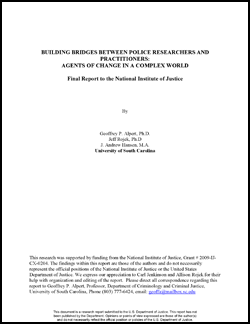
The present study uses a mixed-methods research strategy to examine police practitioner- researcher partnerships. The study has two primary research objectives: (1) examine the prevalence of police practitioner- researcher partnerships in the United States; and (2) examine the factors that prevent or facilitate the development and sustainability of police practitioner- researcher partnerships. The subsequent goals to be accomplished through these objectives are as follows : (1) identify the current level of participation in partnerships with researchers among law enforcement agencies; (2) identify the characteristics of agencies who participate in these partnerships; and (3) gain an understanding of the important lessons learned from practitioners and researchers for forming these partnerships in order to inform future participants in these efforts . The study employs three data- collection strategies to accomplish these objectives and goals. First, a nationally- representative sample of law enforcement agencies was surveyed to capture the prevalence of police practitioner - researcher partnerships and associated information. Second, practitioner and researcher representatives from 89 separate partnerships were interviewed , which were identified through the national survey. The interviews were the primary data-collection effort for gaining insight into the barriers to and facilitators of the development and sustainability of these partnerships, as well as the benefits of partnering . Third, four case studies were conducted on model partnerships that were identified during interviews with practitioners and researchers. While these case studies provide a detailed look at sustainable partnerships, the primary purpose of the case studies is to support a multimedia component of this study. The videos that represent this multimedia component convey important information from one peer to another. This strategy is directed to the practitioner community in order to facilitate dissemination of these important relationships by credible sources.
The national survey revealed that the level of participation in partnerships with researchers by law enforcement agencies is low overall, with only 32% of responding agencies reporting involvement in these relationships. Further examination of the characteristics of these partnerships shows overall participation in formal, short-term and long-term partnerships were less common, 18% and 10% respectively. Participation in either of these formal partnerships is correlated with the size of the agency. Partnerships are also more common among municipal police department s and state law enforcement agencies compared to county agencies. Lastly, agencies which report they use information sources produced by the research community are more likely to engage in partnerships, particularly for those agencies who reported the use of information provided by the National Institute of Justice.
The practitioner and researcher interviews provided important lessons and informal rules necessary to engaging in successful partnerships, which can be grouped into three general areas . First, there are structural characteristics that partners have to negotiate, such as how the partnership will be supported, geographic proximity of partners, permanency of key participants, and the institutional demands for both partners. Second, both parties need to have values that orient them to partnership participation. The agency and its members need to see value in the incorporation of research and involvement of outside researchers, as well as being open to changing the way they do business. The researcher has to emphasize the desire to help and not judge the agency, have a shared stake in improving the agency and community, and value the knowledge of practitioners. Third, both parties have to effectively manage their interpersonal relationship. This involves establishing trust between partnership members and effective and ongoing communication about the expectations, roles, and products of the partnership process.
